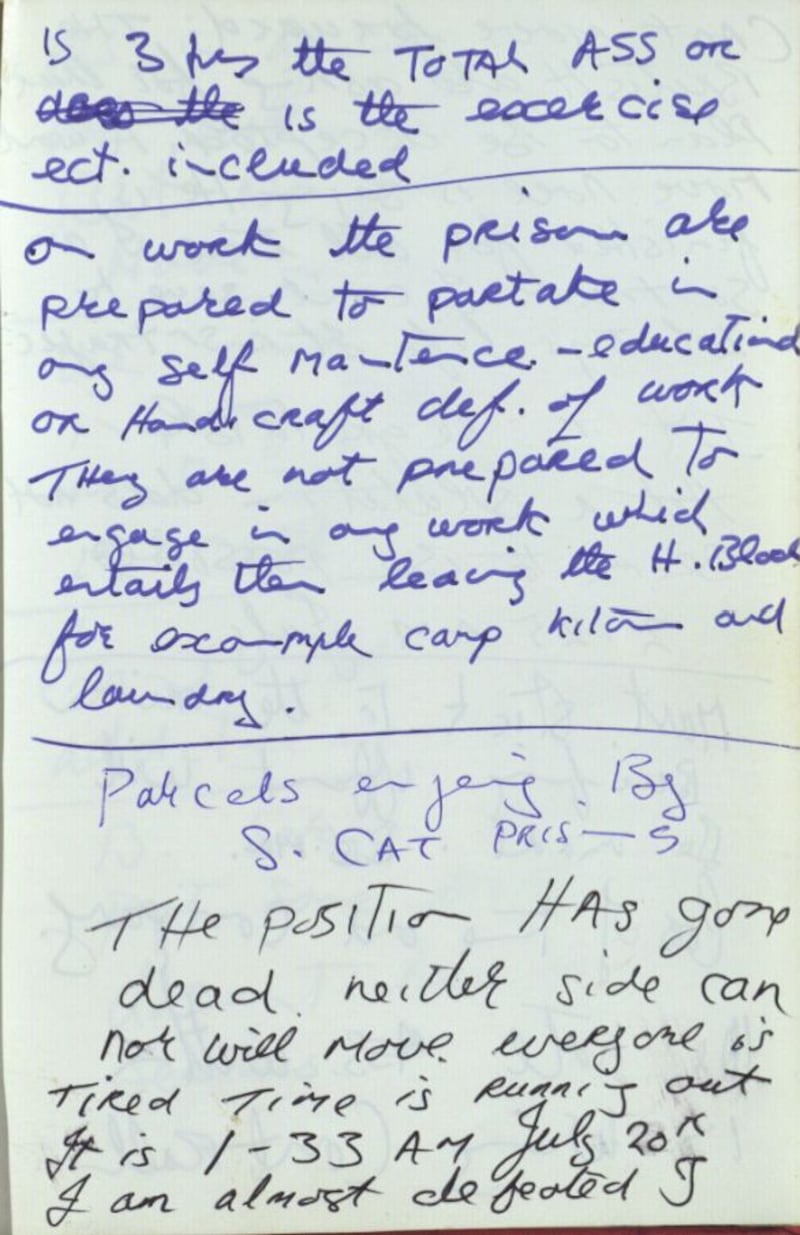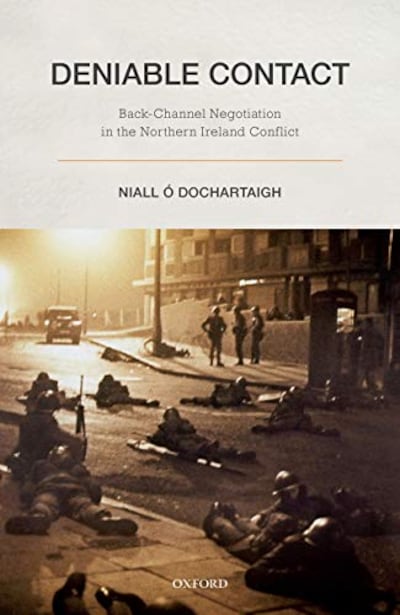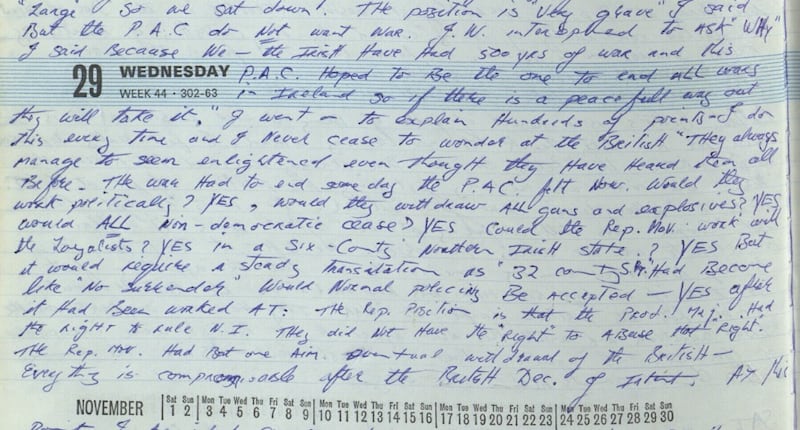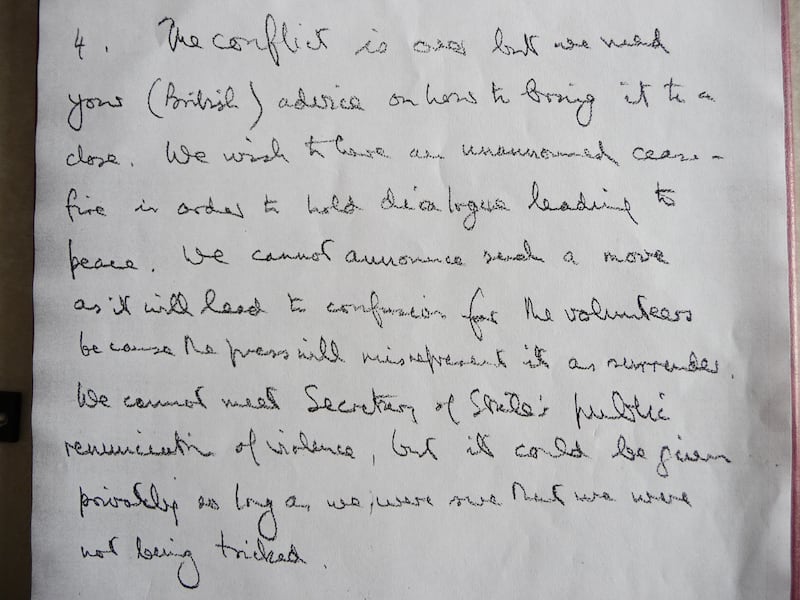In June 1972 British secretary of state for Northern Ireland William Whitelaw told Cabinet colleagues that, after three years of conflict and almost 400 deaths, ‘it was inescapable that some understanding would have to be reached with the “Provisional” IRA; no solution seemed possible unless their point of view were represented’.
The IRA leadership too apprehended from an early stage that the conflict could only be ended by a negotiated compromise; in 1975 key intermediary Brendan Duddy told his interlocutor from Britain’s Secret Intelligence Service (MI6) “[IRA] policy was directed initially to the military defeat of the English, but it became immediately apparent that this was impossible. More slowly it became apparent that the British Army couldn’t militarily defeat the Provos. From the time that they accepted that, Provo violence was aimed at producing a negotiating situation.”
Why then did it take more than two decades and many more deaths to reach a settlement?
The answer is not to be found in the public statements and proclamations of all sides. As Brendan Duddy told me in 2009 “you halved everything you read in the media or you took it as the exact opposite’”. It is necessary instead to examine the back-channel contacts between the British government and the republican leadership throughout the conflict. There is much evidence in the UK’s national archives. The republican leadership too kept detailed records of key phases of contact. But the crucial link between the two is the private papers of intermediary Brendan Duddy.
Duddy’s papers include the diaries he kept during intense periods of negotiation, full of passion and emotions that are absent or muted in the other sources. Triangulated with British government and republican sources and supplemented by interviews with those involved on all sides, they allow a vivid picture to emerge of the complex manoeuvring at this intersection and the difficulty of reaching agreement even when both sides were willing to compromise.

They reveal that this channel was built to a great extent from the middle out by the intermediary who initiated the contact and worked to draw the positions of the two parties closer together. Former Sinn Féin president Ruairí Ó Brádaigh and a former senior British official both told me separately that Duddy was engaged in trying to stretch these two elastic bands – the British and the Republicans – closer together.
I first met Brendan Duddy in 1997 when he phoned me out of the blue at my workplace in the University of Ulster’s International Conflict Research Centre (INCORE) in Derry to say he liked a book I had written and asked me to come to talk with him. I left Derry shortly afterwards to take up a lectureship in Galway but six years later I contacted him about an academic article I was writing. Over the following few years I returned regularly to interview him.

One day in 2007 he slid back the door of a cabinet in his office to reveal the archive he had assembled over the previous 30 years. It included diaries of the secret talks that had taken place in his house in 1975 and 1976 and of the contacts in 1993. There was also a faded and scuffed hardback notebook – he would call it the “Red Book” – his rough handwritten record of the frantic late-night phone negotiations during the 1981 hunger strike in which ten men had died. A year later he phoned me to say he had decided to deposit his papers in Galway and I began to work my way through them.
The archive includes an elliptical and laconic chronology of the channel that seems to have been drawn up by one of the MI6 officers involved. It dates the beginning of “Phase one” to Duddy’s first meeting with MI6 officer Frank Steele in September 1972. Steele’s report of the meeting in the UK national archives describes how Duddy had sent him a message to say that Sinn Féin president Ruairí Ó Brádaigh was asking the British government to take action to strengthen the position of moderates within the IRA against hardliners. Duddy asked for a meeting with Steele “so that he could give the full story personally”.
There is no possibility that Ó Brádaigh had sent such a message. Rather, Duddy was presenting his own analysis of the shared interests of IRA moderates and the British government in the form of a message. Most importantly, it helped to secure a meeting with Steele. The MI6 man impressed on Duddy that he would not deal with him as a “negotiator from the IRA”, but he nonetheless now engaged, through him, in an exchange of positions and views with that organisation over the following months.
Prime minister Edward Heath was kept informed from the outset. During every phase of contact over the following years the British prime minister of the day would be regularly updated and often directly involved.
“Phase one” ended in January 1973 when Duddy expressed his frustration that Steele “had given him no information nor anything which he could use as an inducement to get the Provisionals to cease fire. He felt that he was wasting his time.”
“Phase two” began when Steele’s successor MI6 officer Michael Oatley began to work with Duddy from late 1973 to develop the back-channel into a much more significant and robust channel for communication that would culminate in the 1975 IRA ceasefire. Those involved sought to build trust and co-operation but the channel was also the locus of an ongoing struggle over information.
One report from British official James Allan in January 1974 reports that Duddy had phoned him out of the blue at 1.15am. They spoke for an hour. “The contact . . . had nothing specific to say,” Allan reported, “but clearly wished to find out whether there was anything that we wished to say on any front.” Duddy was seeking to elicit some kind of message or information to bring back to the republicans that might help to stimulate exchange. In one diary entry from 1975 Duddy records a phone call from British official Donald Middleton (DM): “DM phoned. Asked, how are you? Which is always the prelude [to] a fact-finding mission.” It captures that sense of caution, mistrust and the desire to control information that always ran alongside the efforts to build trust.
The channel sheds light too on the long-term political direction of the republican movement. In 1974, five years after the outbreak of the conflict, Sinn Féin was still a proscribed organisation in the North. The leadership wanted to contest elections but did not know if their candidates would be arrested.

Duddy, claiming to speak on behalf of the republican leadership, asked the British if Sinn Féin candidates would be allowed to stand for election in Northern Ireland and whether they would be arrested if they did so. He said the movement’s leadership had agreed that Sinn Féin could contest elections if the British made a statement on the issue, preferably removing the ban but at least making clear that candidates could stand without fear of arrest.
The British now moved very quickly on the issue despite the fact that “there might well be accusations we were negotiating with the IRA”. Just two days later, Northern Ireland secretary Francis Pym gave a speech in which he said there was no reason that those who supported the political views of “for example the UVF and Sinn Féin” should not do so: “All we ask is that such views should be advanced through the democratic processes.”
There has been much talk in recent years of the British enticing republicans into political activity but this paints a different picture, of a British government acceding to a request from the republican leadership because it fitted with the limited shared interests of both parties.
The republican leadership was seeking to strengthen its position by building its electoral power while the British hoped that increasing political activity by the republican movement might see them move away from the armed campaign.
These contacts culminated in the 1975 IRA ceasefire and secret talks between the British and republicans in Duddy’s house in Derry that continued for much of that year. The talks would end in failure but not for the reasons that are usually advanced. It has often been said the British were just using the ceasefire to weaken the IRA but in May 1975, a few months into the truce, the head of the British army in the North, General Sir Frank King, and his senior officers believed the exact opposite, complaining to secretary of state Merlyn Rees that: “The PIRA were becoming stronger every day, but the Security Forces were becoming weaker . . . It would take a considerable time now to reverse the PIRA’s new-found strength.”
In fact, the 1975 talks were a genuine attempt to negotiate a settlement, while both sides simultaneously manoeuvred for military and political advantage in the event of failure or breakdown.
After the ceasefire ended a new secretary of state, Roy Mason, turned away from efforts to negotiate with republicans but provided no political alternative. In the absence of any clear political vision or policy, there was a steep escalation of confrontation in the prisons that culminated in the hunger strike of 1981.
The back-channel began with a fake message in September 1972 and it would end with a similar message in 1993.
Duddy, who once again acted as intermediary and attempted to negotiate a compromise, hoped that a settlement of the hunger strike would open the way to re-engagement on a peace settlement: “What I saw was the opportunity of renewing the dialogue between the British and the IRA . . . dialogue to stop the bigger picture, to stop the war,” he told me. Instead the failure to negotiate the hunger strike would push the British and the republicans further apart than ever before, and push the eventual settlement far into the future.
The back-channel began with a fake message in September 1972 and it would end with a similar message in 1993. In 1991 the channel between the British government and the republican leadership through Brendan Duddy was reactivated. Following two years of secret contact there had been very little progress. Then, in February 1993, the British government received a message purported to be from the IRA – which it was not – that said “The conflict is over but we need your advice on how to bring it to a close”.

The message was not the product of a single hand but emerged from a collaborative process involving the British representative Robert McLaren and intermediary Brendan Duddy, who was in turn working closely with two colleagues. It reflected Duddy’s and his colleagues’ understanding of the republican willingness to end the IRA campaign, phrased in a way that would be likely to prompt action by the British government.
Just like that September 1972 message it was phrased in terms the republicans would never have used. And just as the fake message in 1972 had helped to open the way to engagement by Frank Steele, the “conflict is over” message in 1993 allowed those on the UK side who favoured a negotiated compromise to push forward and generate movement on their own side as part of a process that would culminate in the IRA ceasefire of August 1994.
Engagement between the republican movement and the British state was crucial to the ending of violent conflict. Republican efforts to move towards peace required a co-operative relationship with the British state as only the British state had the capacity to deliver the limited gains that would make it politically feasible to end the IRA campaign.
During the long decades when open contact was impossible, intermittent back-channel contacts allowed those on opposing sides to build mutually beneficial relationships in the most difficult of circumstances, and to develop a degree of mutual understanding.
The back-channel was a locus not just for communication but also for the generation and propagation of new ideas, a site where the intermediary for whom a settlement was the overriding priority exercised a certain independent power. That power derived in large part from the accumulation of information in that privileged and protected space between the parties: Duddy, the intermediary, could seal it in metaphorical boxes, to be opened at an opportune time, when sharing knowledge, with one side or another, might further the project of settlement.
If a co-operative dynamic emerges in many negotiations, it is a defining feature of back-channel negotiations, characterised, as they are, by a shared commitment to secrecy and the exclusion of internal opponents. Above all, a back-channel, when it works, is a means of transforming relationships between opponents in the most intractable conflicts. Both parties, working together on a shared project of secrecy, were able to develop limited trust, learn about the limits to which their counterparts could go, and begin to develop a new and less confrontational relationship.
Niall Ó Dochartaigh is personal professor of political science and sociology at the National University of Ireland Galway and author of Deniable Contact: Back-channel Negotiation in Northern Ireland (Oxford University Press, 2021)










